February 2010 Archives
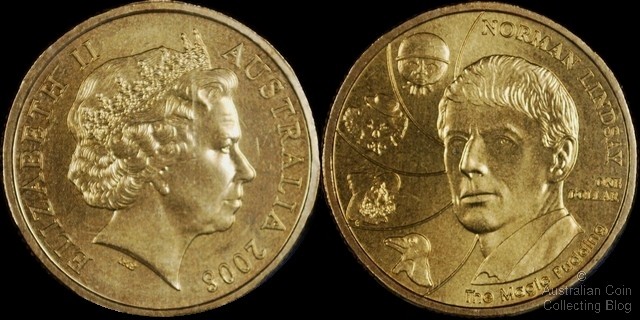 2008 Unc Norman Lindsay
2008 Unc Norman LindsayFamous Australian artist Norman Lindsay (1879-1969) was also renowned for his work as a writer of childrens stories. First published in 1918, The Magic Pudding is a classic childrens novel that Lindsay wrote and illustrated. It was adapted for an animated feature film in 2000. The classic story has been reprinted numerous times and was done so again in 2008 to celebrate the 90th anniversary of the book. Following with the humorous side to this book it is divided into 4 "slices" instead of chapters. It follows the magic pudding who, as eaten, reforms to be eaten again as its' owners defend it from the pudding thieves.
The theme for the baby mint and proof sets produced by the Royal Australian Mint in 2007 and 2008 was The Magic Pudding by Norman Lindsay. A fitting theme for a set designed as a gift to commemorate a special newborns birth. The packaging features artwork from the Magic Pudding story by Lindsay himself. The Norman Lindsay one dollar is only featured in the baby mint set, not the proof set.
The reverse depicts a portrait of Lindsay with 4 characters from the story to the left of the portrait. From the top the coin features the Magic Pudding, Bunyip Bluegum the koala, Bill Barnacle the sailor and Sam Sawnoff the penguin. The legends read "Norman Lindsay The Magic Pudding One Dollar" on the reverse. This design was by Vladimir Gottwald but does not bear his initials.
It is a standard size 25mm 9 gram Australian legal tender aluminium bronze one dollar coin but was not released into circulation (thus an NCLT), it is only found in the baby mint (uncirculated) set. The obverse is the standard Ian Rank-Broadley effigy of Queen Elizabeth II. In 2007 33,693 baby mint sets were produced and in 2008 46,504 sets were sold which included this exclusive coin design.

Australia 1991 25th Anniversary of Decimal Currency 50c
The 14th of February 1966 was 'C Day', when Australia changed from the pounds, shillings, and pence system to a decimal system of dollars and cents. It was a massive event with shopping tills and calculators across the country needing to be modified and replaced, the government had to have more than a billion new coins minted and ready to be unleashed on the public, and the public themselves had to be extensively educated in the new decimal system. Preparation had begun years before with the first decimal coins minted in 1964, eventually decimal coins for 1966 were minted in London, Melbourne, Perth, and the new Royal Australian Mint in Canberra. 1991 saw the 25th anniversary of the introduction of decimal currency and the RAM decided to celebrate it with an attractive commemorative 50c coin that was released into circulation.
Decimal coins in 1991 had the Raphael Maklouf portrait of Queen Elizabeth II on the obverse. The reverse of this commemorative coin was designed by RAM master sculptor Horst Hahne using the rams head from the Australian shilling which was minted from 1938 to 1963 and his own legend which reads "50 Cents : 25th Anniversary of Decimal Currency". The rams head is the same as originally sculpted by George Kruger Gray. 4,704,000 of these coins were struck in copper nickel for circulation, another 169,557 to brilliant UNC standards for mint sets, and 41,590 in proof for the 1991 proof sets. 25,000 were also struck in sterling silver for the 1991 Masterpieces in Silver set.
The 1991 25th Anniversary of Decimal Currency 50c is one of the lowest mintage circulating commemorative 50c coins and as such you don't often see them in your change. There were still nearly 5 million of them made though, so it is by no means a scarce coin and only really worth more than face value if it is uncirculated, when it is worth $7-$10. A proof cupro nickel coin might fetch up to $20 while the sterling silver coin from the Masterpieces in Silver set can be had for $30. Interestingly security rolls of this coin are quite scarce and do fetch decent prices of $150 and up.
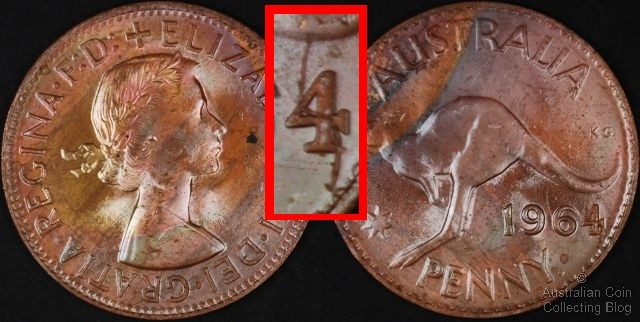 1964Y Penny Struck Through Wire or Cotton
1964Y Penny Struck Through Wire or CottonThe strike through or strike thru error term is given to an error observed on a coin where there is an incuse marking on the coin that looks as if there was something on or adhering to the coin surface at striking. This might me a piece of wire, metal or a piece of string or grease or some other foreign material. On occasions the foreign matter may still be stuck to the coin!
During cleaning or maintenance of the coin press, oil or grease needed to maintain the presses mechanical activity may get onto the surface of the die. If a coin is struck though oil then the resulting coin will have the appearance of a missing piece in the design or a poorly struck surface. It is also termed filled die or struck through grease filled die. This is often more impressive on a coin missing important features such as a letter in the date or even the entire date. The effect of a strike through oil may have the appearance that the surface (in that area) has been harshly cleaned or machined down, this is because of the texture of the foreign material and the concave impression it gives to the coin surface.
It is common to find coins struck with greasy or even rusty dies resulting in poorly struck surfaces, features or legends. This is really just poor quality control from the mints resulting in poor quality coins rather than collectable error coins. If the strike through is spectacular then expect a premium price for the coin.
It's important to look at both sides of the coin and if this weakness appears on both sides of the coin then it's not likely to be oil on the die but a thinned part of the planchet or if it's uniform around the coin may be a weak strike.

1962 Sixpence Struck Through Oil
There was an example I have seen of a strike through red cotton on the coin surface and the resulting struck coin still had the piece of red cotton attached! Fitters who work on the presses at the RAM use red rags to clean the presses and die surfaces. Seen in one of our previous articles are the fitters changing the dies on the gallery press and the red rag in use for clean up (see top image in link).
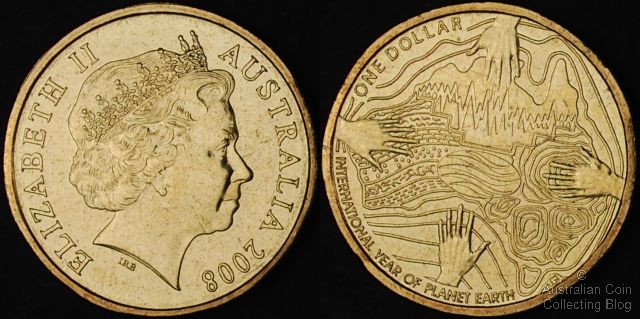 2008 Unc International Year of Planet Earth
2008 Unc International Year of Planet EarthThe United Nations declared 2008 International Year of Planet Earth adopting the theme "earth sciences for society". Geological hazards are a key issue for the United Nations and promoting this year was the biggest international effort to promote this field of scientific endeavour.
UNESCO (United Nations Educational Scientific and Cultural Organisation) hoped to raise 20 million dollars over the 3 year period 2007-2009 to fund research and outreach activities. Objectives of the year included
- discovering new natural resources and make them available in a sustainable manner
- reduce risks for society caused by natural and human-induced hazards
- increase interest in earth science encouraging young people to study this at university
- improved understanding of the evolution of life
- understanding the earth from crust to core.
The reverse of this one dollar coin was designed by Vladimir Gottwald. His designs were inspired by the program, highlighting our need to take responsibility for our planet and issues of hazard minimisation and sustainable development that are of significance to all Australians. The reverse of the IYPE $1 depicts a map of Australia with human hands showing the change we effect on the environments.
This aluminium bronze dollar is the standard 25mm 9 gram size for a circulation one dollar but was not released into circulation, thus is termed a NCLT release. It features the standard Ian Rank-Broadley effigy of Queen Elizabeth II on the obverse. The only way to purchase one of these coins in uncirculated condition is in a mint year set for 2008 or a 2 coin uncirculated set released by the Royal Australian Mint. A proof version can be found in the 2008 proof year set. It was also issued in sterling silver in the 2008 fine silver year set for 2008. For mintages see the 2008 issues and mintages table.
Following on from our previous article about an exciting find in change we have some more information to add about how this coin has come about.
As per the RAM press release dated 11 November 2008 the Royal Australian Mint buys coin blanks from a South Korean company Poonsang. This company won the tender to produce the blanks for the Australian Mint.
From the Poongsan annual report 2008
Over the past forty-one years, Poongsan has earned a reputation as a trusted supplierof coin blanks to the global market. The company was designated as the Republic of Korea's sole coin blank manufacturer by the Korea Minting and Security PrintingCorporation in 1970. Poongsan first exported coin blanks to Taiwan in 1973, and sincethen has supplied its coin blanks to over 60 countries on 6 continents. As a recognizedparticipant in the production of Euro coins, Poongsan not only continues to supply coinblanks to the EU market but also has, in collaboration with major European Mints,expanded to include Slovenian Euro coin blanks in 2006 and Cyprus Euro coin blanks in2007. Additionally, in 2008, Poongsan continued its global market expansion with salesto Brunei, Chile and Venezuela. Today, 36 years after its first export, Poongsan is theworld's largest coin blank manufacturer, accounting for more than half of the world'scoin blank trade volume.Poongsan casts over 50 different types of coin blank materials - from brass, nickel sil-ver, cupronickel, and aluminum bronze to other special copper alloys. In recent years,Poongsan has concentrated on meeting the global demand for bi-metal, clad metal andnordic coin blanks. Poongsan has also expanded its coin blank production to includestainless steel coin blank
Points to note from the quote above:
- Poongsan produces blanks that are sold to Venezuela
- Poongsan produces bi-metal blanks
Therefore it is not impossible that a rogue bi-metal blank intended for Venezuela snuck into the drum of blanks destined for Australia. These bi-metal blanks supplied by Poongsan for the Venezuelan 1 Bolivar coin come with the edge lettering applied at manufacture in the Poongsan facility in South Korea.
Coin blanks are imported by the Royal Australian Mint in huge 44 gallon drums pre cut ready to be fed straight into the presses. These huge drums of blanks are moved around the mint by the "Titan" robot seen here (I'm trying to paint a picture in your head). Factories overseas process strips of metal and cut out the coin blanks for many countries right around the world, with some companies producing blanks for more than one country.
Fast forward now to newly pressed one dollar coins leaving the RAM in bags to the Armaguard facility to be rolled into manageable $20 lots before distribution to banks and major retailers Australia wide. A particular mob of roos one dollar is packaged into a roll destined for a Woolworths supermarket. The checkout chick cracks that roll and the shiny new loose dollars are in the till ready to be given out as change. One very lucky lady is given one of these dollars in her change and gives this coin a second look as she leaves the supermarket. When she gets home she has a third look at her coin which looks just a bit different to all the other mob of roos dollars she has seen before.
This lucky lady has just won the lottery, she just doesn't quite know it yet. Those in coin coin collecting circles would gasp at what this coin is.... shall I share?
This 2009 mob of roos one dollar coin has spectacular eye appeal, it looks to have been struck on a foreign bi-metal planchet! Now the chances of a foreign blank of distinguishable difference getting into the drum of blanks, being struck -being the right size to be struck, passing the mint's strict quality controls, passing through Armaguard's hands, gone unnoticed by the checkout chick and into the hands of it's lucky new owner, are pretty slim.
This dollar has a stainless steel inner core and a aluminium bronze outer ring not seen on any other Australian coins that I know of. There have been releases here of bi-metal coins with an aluminium-bronze core and a stainless outer ring but not vice versa.
The other interesting thing about this coin is it has what appears to be some edge lettering "BCV1", now this actually stands for Banco Central De Venezuela. A coin from Venezuela! A 1 Bolivar to be exact, a bi-metal coin of 24mm weighing 8.1 grams. These facts are yet to be confirmed with the actual coin in hand but it's pretty certain from the images that this mob of roos dollar could have been struck this well (slightly weak on the edge reeding) on a bi-metal 1 Bolivar slightly undersized blank from Venezuela.
What a magnificent piece to add to your collection, now the next question, a coin given in change for $1 -what is it worth? I expect anywhere from $1,000+ but this is a one off magnificent piece how much do you think?
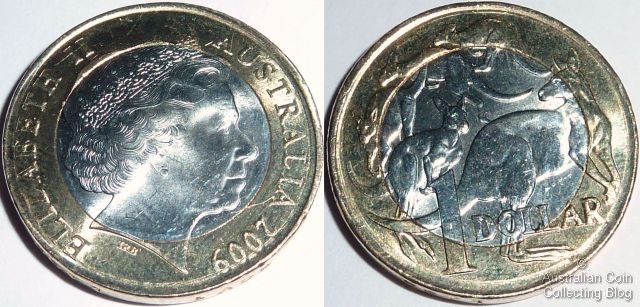 2009 One Dollar given in change at Woolworths supermarket
2009 One Dollar given in change at Woolworths supermarket Edge Lettering
Edge LetteringSee 2009 Australian Mob of Roos Dollar Struck on Bi-Metal Planchet follow up entry for new information as it comes to light.
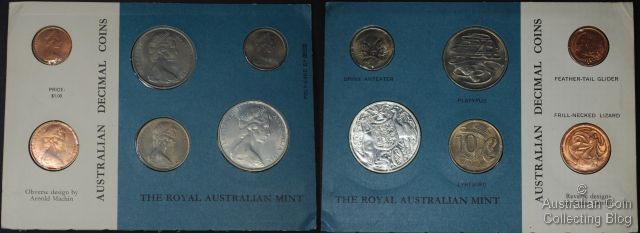
Australian 1966 Carded Mint Set
February 14th 1966 saw the introduction of decimal coins into circulation in Australia and for the first time the Royal Australian Mint made uncirculated grade coins in sets available to collectors and visitors to the mint. The very first of these sets were coins sealed in plastic and then sealed in a blue and white cardboard holder which was initially available only to visitors to the new Royal Australian Mint facility in Canberra. The sets included an example of each of the new decimal coins, the 80% silver round 50c coin, the cupro nickel 20c, 10c, and 5c and finally the bronze 2 and 1 cent coins. With a total face value of 88c these carded mint sets were available for just $1 (just a 14% markup), a far cry from the margins achieved with mint product sold these days (the 2010 mint set has a massive 679% markup)!
 RAM Ad in Australian Coin Review, October 1966 |
The new decimal coins all had a common obverse portrait of Queen Elizabeth II by Arnold Machin, while the reverses depicting typically Australian wildlife were all designed by Stuart Devlin. 77,250 of the sets were issued during 1966 and 1967, but shortages of Australian minted 20, 10, and 5 cent coins meant that 67,250 of the sets contained London (which had been minting Australian decimal coins since 1965) minted cupro nickel coins. The remaining 10,000 sets contained 20, 10, and 5 cent coins that were minted in Canberra and continued to be available right though until early 1967. |
As is normal for most numismatic collectables, condition is everything with regards to the value of these sets. Prices for these sets currently range from $40 or so for a poor set that is damaged or written on, up to $80+ for a pristine set with un-toned copper coins. It is quite common for these sets to be found stapled across the top and we're not sure if this was done by the RAM at time of issue or later by collectors to stop the paper separating. Either way the stapling does have some effect on the value with the staples often rusting and staining the cardboard. Just recently we saw a lovely 1966 carded mint set sell at an auction in Canberra with the original RAM packing slip, this went for $140. This was the first time we've seen one come up for sale with the packing slip. You can see an image of a packing slip below (we've been lucky enough to secure a number of these sets with slips just in the last few days).

Australian 1966 Carded Mint Set Packing Slip
To have the original slip, an unstapled set with pristine coins in undamaged or non dog-eared cardboard is certainly a superior set to look out for, if you can find one!
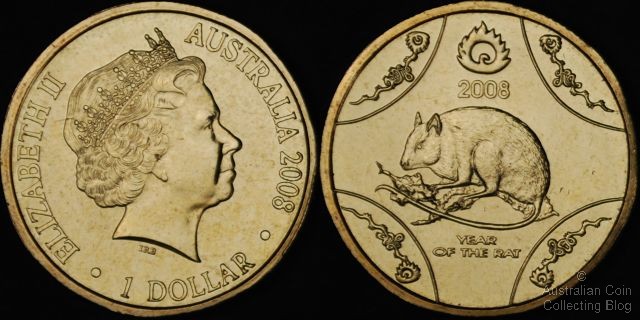 2008 Unc Year of the Rat
2008 Unc Year of the RatIn 2008 the Royal Australian Mint continued with the second release in an ongoing series of NCLT (non-circulating legal tender) one dollar coins depicting each lunar year and their representative animals. Intended as a collectors coin this 2008 $1 marks the birth of a loved one or a birthday gift for those born in the year of the Brown Earth Rat which begins on February 4th 2008, the first day of the solar month in thew Chinese Lunar calendar. Those born in 1996, 1984, 1972, 1960, 1948, 1936 or 1924 were also born into the year of the rat. The rat is the first in a cycle of 12 astrological animals. Virtues of those born into the sign of the rat are said to be charming, sensitive, imaginative and generous to the ones they love. They enjoy being leaders so are often successful in life and are said to have the gift of insight and clairvoyance. Those born into the year of the rat are also said to have a tendency to be quick tempered, over-critical perfectionists.
The Year of the Rat one dollar reverse was designed by Vladimir Gottwald but does not feature Gottwalds signature initials in the design. The reverse features a rat with authentic chinese symbols all in a symetrical design on the reverse. The coin is issued in a protective capsule housed in an informative card. This card features a red and gold design, the traditional colours of good fortune in Chinese culture. The coin reads "2008 Year of the Rat" on the reverse and, different to other standard dollar issues, states the denomination "1 Dollar" on the obverse below the portrait. It is the standard 25mm size, 9 gram, aluminium bronze one dollar coin with the Ian Rank-Broadley effigy of Queen Elizabeth II.
This year of the rat aluminium bronze one dollar was issued in uncirculated condition for $12.95 with a mintage of 20,359. It was also issued in silver proof 11.66 gram 25mm for $40 with a mintage of 5,250. The design was also issued also in a (1/10oz 17.53mm) $10 gold proof coin for $175 with a capped mintage of 2,500.
Back in January 2010 we talked about the differences between coins minted on gallery press 1 and 2 at the RAM. There was a reason for this, some collectors seem to think that having coins from both presses is essential for a complete dollar coin collection due to the differences in the reeding positions of coins produced on each press. We've thought for some time that this is a bit silly because as far as we were aware the reeding position is essentially random, with the collar position not fixed with respect to the obverse and reverse dies. Our reasoning was if you were going to declare the gallery presses as a distinct variety then you must logically say that each circulation coin with a different reeding position must be collected too. And how many of those are there? Well no-one knows, remember the reeding position can change every time there is a die change in a coining press making Australian dollars.
We'd let this lie until some people started suggesting that the reeding position of coins could be used as a definitive test to identify both gallery press coins and portable press coins from earlier years. This assertion was made based on a sample of just one or two coins from just one person's coin collection! Clearly this made no sense so as an interesting exercise we recently attended the RAM and minted a few more coins on the gallery presses and took a look at the reeding positions. And what do you know? They are different to those on coins minted just a month a go on New Years Day! You can see below two coins minted on gallery press 1 and how the reeding positions vary.

Gallery Press 1 minted 1 January 2010 on left, Gallery Press 1 minted 30 January 2010 on right
As you can see the positions are quite different, so the fitters at the RAM have had the collar out of gallery press 1 at least once in the intervening 30 days. Perhaps more, who really knows. So while we can admire someone trying to ensure the completeness of their collection we can only suggest that it's entirely pointless unless you attend the mint every day to ensure the dies are not changed. And to suggest that reeding positions can be used to identify the press on which a coin is made without a huge sample size and proper investigation is clearly spurious at best, and potentially harmful at worst.
Just recently I and my fellow Australian Coin Collecting blog author were able to attend a smallish coin auction for both the lot viewing session and the live room auction the next day. The company holding the auction has been in business for more than 30 years and in this time has conducted quite a few more than 100 auctions. We've been to several of their auctions in the past and usually the experience isn't too bad at all. However this time a few things really got under my skin during the viewing of the lots and I feel like I should talk about them.
- Don't buy lots site unseen, view view view. If you can't view then get someone to view for you. Many of the coins we looked at that were described as uncirculated were clearly not, and a surprisingly large number of the coins were clearly cleaned or affected by PVC.
- The lots were incredibly poorly setup for viewing. In many cases the coins were sealed into PVC holders which normally isn't too bad for viewing and short term storage but the particular type of holders used were spotted with tiny black flecks so as a consequence every coin appeared to be spotted with tiny black flecks.
- Some lots with more than one coin had the coins sealed into PVC holders and then those PVC holders were sealed into a larger PVC holder. This made it impossible to view these coins properly because of the lack of clarity in the PVC and the fact that the coin dealer was trying to make everyone look through two layers of this horrible plastic.
- Most of the lots were labelled with a number written onto a white adhesive label. Now one would think the obvious place to put this was on the white note card attached to all the lots, but no, in some cases they'd decided to stick the white label on the coin holder so you couldn't see the coin because of the label.
- One high value lot was so poorly packed that it was virtually impossible to view without damaging the item for sale. We managed to remove it from the holder to view correctly but I could see how hundreds of dollars of value could be removed in just a few seconds by someone carelessly removing the lot from the holder and damaging it when all they want is a closer look.
- We understand that staff who conduct auction viewings have many demands on their time but this is no excuse for damaging the lots they are there to try to sell. We saw one staff member fold a high value item (which should have remained flat) and try to stuff it back into the holder it came from because he was clearly busy and impatient. There is absolutely no excuse for this and we were horrified when we saw it, any chance that anyone in the room would have bid on that item just went out the window (incidentally the item went unsold).
OK so now I've got that off of my chest here's some things I would change to make the viewing experience much easier.
- Get the coins out of the PVC holders. Put them into mylar flips (SAFLIPS would be good) and heat seal those coins in there. The mylar will protect the coin, it is contained, and the plastic is crystal clear allowing for easy viewing. If there's multiple coins in a lot then heat seal them into polypropylene album pages cut to size (like we did here). By all means then put the sealed up coin (or coins) into a larger PVC pocket and staple this to an information card. People can then take the coins out of the PVC pocket and view very easily. Doing these things will make for an easier viewing and also reduce your auction setup costs, it is far quicker to heat seal coins into holders than staple them or sticky tape them!
- Take some basic care when labeling lots. Sure we understand they need to be labelled so you can keep track but for goodness sake don't stick the label on top of the coin so we can't view it. If we can't view it we wont buy it.
- Take some care when handling lots and employ staff with some basic numismatic knowledge (or at least take the time to train them afterwards). I can think of several occasions now in auction viewings and coins stores where the staff have damaged items I was interested in buying because of poor handling, lack of care, or just plain ignorance. Clearly this is unacceptable.
- Apply conservative, consistent, and open grading when evaluating lots for your catalogue. If your lots are consistently overgraded, cleaned, and have faults that are not described then you will not receive site unseen bids and lots will not realise their real value. It's as simple as that.
I'm glad to get that off of my chest, the viewing was a frustrating experience and so easily improved with just a bit of thought and care being taken. The actual room auction was smooth and well run but as you'd expect the clearance rate was fairly ordinary. I wonder if it could be improved by taking some of the simple steps I've outlined above?


